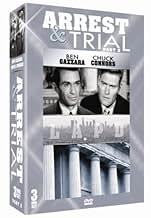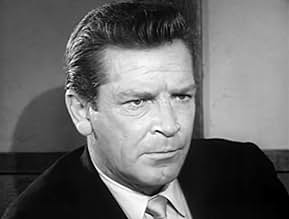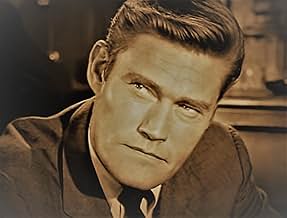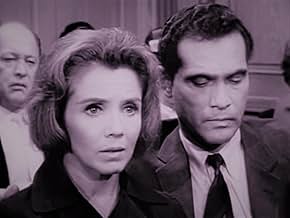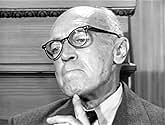Füge eine Handlung in deiner Sprache hinzuLos Angeles is where Sergeant Nick Anderson and his fellow officers work to keep the streets safe. After the arrest of the accused, attorney John Egan plans their defense, while the prosecut... Alles lesenLos Angeles is where Sergeant Nick Anderson and his fellow officers work to keep the streets safe. After the arrest of the accused, attorney John Egan plans their defense, while the prosecution is led by Jerry Miller.Los Angeles is where Sergeant Nick Anderson and his fellow officers work to keep the streets safe. After the arrest of the accused, attorney John Egan plans their defense, while the prosecution is led by Jerry Miller.
- Für 4 Primetime Emmys nominiert
- 4 Nominierungen insgesamt
Folgen durchsuchen
Empfohlene Bewertungen
When Dick Wolf was creating "Law and Order", he was told there had already been a show that followed a crime from it's commission through the investigation the arrest and the subsequent trial. It was called "Arrest and Trial" and was on from 1963-64, a quarter century before the pilot for "Law and Order", (I'll call them A&T and L&O). Wolf screened an episode of A&T and concluded that their show was very different from his. He was right. The biggest difference, however, was not in concept but in time.
A&T is a 90 minute show, L&O an hour. L&O is a story-driven show with the nature of it's characters suddenly and starkly revealed. A&T is a character study that shows situations developing over time and their effect on people as they happen. In L&O the cops are cops but the lawyers are prosecutors, attempting to forge justice using the imperfect tool of the law. Their adversaries are usually rather sleazy criminals who cared about no one but themselves and their equally self-interested attorneys, people who care nothing about law or justice but just want to win. In A&T the cops are part psychoanalysts and the criminals victims of tragic circumstances. The lawyers are highly principled defense attorneys. The prosecutor is a very friendly adversary who almost reluctantly does his job, even though he may even be sympathetic toward the accused. L&O is mostly about legal issues as the lawyers dual with each other. Whatever moral issues come up have been violated by the criminals. In A&T, there is always some great moral issue that dominates the question of whether the accused is guilty of the crime. How do we treat the insane? Drug addicts? The emotionally distraught?
When I had a chance to view A&T myself after many years of watching L&O, I found it a pleasant surprise, perhaps the most underrated show of my favorite TV decade, the Sixties. The length and emphasis on crime as human tragedy provided some very fine actors such as James Whitmore, Joseph Schildkraut, Mickey Rooney, Roddy McDowell, (who starred in a version of "Crime and Punishment") and many others with tours de force. The writing and acting was very strong. Ben Gazzara, (who I recently spotted in an L&O episode, with his voice apparently dubbed for some reason- I hope he isn't having health problems), played a very thoughtful and sympathetic policeman and Chuck Conners was fine and forceful as an idealistic attorney. It's a consistently entertaining show, one that covers much of the same ground as the excellent "The Defenders" from the same period.
But it's clearly a product of it's time. There are no bad guys. The victims are often faceless or minor characters. Prosecutors and defense attorneys are brothers in arms, fighting for what's right. There's never talk of a deal. This was from a time when, in the last generation, we'd survived a depression, won a war, were holding back Communism and reaching for the moon. We were going to get rid of poverty and injustice. A great many shows presented the contemporary world, one with problems but problems which seemed soluble with heroic effort. Dr. Kildare, Mr. Novak, The Defenders, East Side West Side, Naked City, even Route 66. A&T was definitely a product of this environment.
L&O is product of a much more cynical age, one where people are grubbing for whatever they can get, protecting their own interests and bending the law anyway they can to get what they want out of it.
A&T is a 90 minute show, L&O an hour. L&O is a story-driven show with the nature of it's characters suddenly and starkly revealed. A&T is a character study that shows situations developing over time and their effect on people as they happen. In L&O the cops are cops but the lawyers are prosecutors, attempting to forge justice using the imperfect tool of the law. Their adversaries are usually rather sleazy criminals who cared about no one but themselves and their equally self-interested attorneys, people who care nothing about law or justice but just want to win. In A&T the cops are part psychoanalysts and the criminals victims of tragic circumstances. The lawyers are highly principled defense attorneys. The prosecutor is a very friendly adversary who almost reluctantly does his job, even though he may even be sympathetic toward the accused. L&O is mostly about legal issues as the lawyers dual with each other. Whatever moral issues come up have been violated by the criminals. In A&T, there is always some great moral issue that dominates the question of whether the accused is guilty of the crime. How do we treat the insane? Drug addicts? The emotionally distraught?
When I had a chance to view A&T myself after many years of watching L&O, I found it a pleasant surprise, perhaps the most underrated show of my favorite TV decade, the Sixties. The length and emphasis on crime as human tragedy provided some very fine actors such as James Whitmore, Joseph Schildkraut, Mickey Rooney, Roddy McDowell, (who starred in a version of "Crime and Punishment") and many others with tours de force. The writing and acting was very strong. Ben Gazzara, (who I recently spotted in an L&O episode, with his voice apparently dubbed for some reason- I hope he isn't having health problems), played a very thoughtful and sympathetic policeman and Chuck Conners was fine and forceful as an idealistic attorney. It's a consistently entertaining show, one that covers much of the same ground as the excellent "The Defenders" from the same period.
But it's clearly a product of it's time. There are no bad guys. The victims are often faceless or minor characters. Prosecutors and defense attorneys are brothers in arms, fighting for what's right. There's never talk of a deal. This was from a time when, in the last generation, we'd survived a depression, won a war, were holding back Communism and reaching for the moon. We were going to get rid of poverty and injustice. A great many shows presented the contemporary world, one with problems but problems which seemed soluble with heroic effort. Dr. Kildare, Mr. Novak, The Defenders, East Side West Side, Naked City, even Route 66. A&T was definitely a product of this environment.
L&O is product of a much more cynical age, one where people are grubbing for whatever they can get, protecting their own interests and bending the law anyway they can to get what they want out of it.
This short-lived series was excellent TV for its time.
Half the show was about the police and the other half was about the courts. In the context of some of the TV we see today, doesn't this have a familiar air about it?
"Law and Order"and it's various spin-offs are presently among the most popular shows on TV. This tends to suggest that "Arrest and Trial" was perhaps 40 years ahead of its time.
Half the show was about the police and the other half was about the courts. In the context of some of the TV we see today, doesn't this have a familiar air about it?
"Law and Order"and it's various spin-offs are presently among the most popular shows on TV. This tends to suggest that "Arrest and Trial" was perhaps 40 years ahead of its time.
Created by Earl Bellamy, "Arrest and Trial" was an early attempt to meld, a la "Law and Order", the processes of apprehending criminals, then following the legal system as the cases would be resolved. As 'cop' shows and 'lawyer' shows were among television's most popular genres at the time, ABC and Universal thought the program would be a major hit, and provided first-class talent both in front of, and behind the camera.
The 'Arrest' phase starred 33-year old Ben Gazzara, a highly respected actor who had made his mark on Broadway in "Cat On a Hot Tin Roof", and in film, in ANATOMY OF A MURDER. Possessing a quick, analytical mind, and a wry sense of humor, Gazzara's 'Nick Anderson' would quickly cut through alibis, and make arrests, aided by fellow detectives Roger Perry ("Harrigan and Son") and Noah Keen ("The Crimebusters").
The 'Trial' phase returned TV's "Rifleman", Chuck Connors, to the small screen, as John Egan, an intimidating yet sensitive attorney, and featured veteran actors John Larch (WRITTEN ON THE WIND) and John Kerr (SOUTH PACIFIC) as D.A.s representing the State.
While not as intellectual as "The Defenders", "Arrest and Trial" was unique as either side could win or lose a case, as opposed to Perry Mason's nearly flawless record. This was heady stuff for the early sixties!
Unfortunately, being on television's 'Number 3' network did the series in, as ABC had a much harder time attracting viewers than CBS and NBC, particularly when the program was promoted as 'quality'.
It would take 30 years before "Law and Order" could make the formula work!
The 'Arrest' phase starred 33-year old Ben Gazzara, a highly respected actor who had made his mark on Broadway in "Cat On a Hot Tin Roof", and in film, in ANATOMY OF A MURDER. Possessing a quick, analytical mind, and a wry sense of humor, Gazzara's 'Nick Anderson' would quickly cut through alibis, and make arrests, aided by fellow detectives Roger Perry ("Harrigan and Son") and Noah Keen ("The Crimebusters").
The 'Trial' phase returned TV's "Rifleman", Chuck Connors, to the small screen, as John Egan, an intimidating yet sensitive attorney, and featured veteran actors John Larch (WRITTEN ON THE WIND) and John Kerr (SOUTH PACIFIC) as D.A.s representing the State.
While not as intellectual as "The Defenders", "Arrest and Trial" was unique as either side could win or lose a case, as opposed to Perry Mason's nearly flawless record. This was heady stuff for the early sixties!
Unfortunately, being on television's 'Number 3' network did the series in, as ABC had a much harder time attracting viewers than CBS and NBC, particularly when the program was promoted as 'quality'.
It would take 30 years before "Law and Order" could make the formula work!
This was one of the "big" shows that came with the mid-'60s. ARREST AND TRIAL attempted to combine the standard "cop" show with a "lawyer" offering that blossomed in the early 1960s -- not to include of course PERRY MASON, by then an old warhorse.
Half the story was the detection/ manhunt/ apprehension, whilst the other half concerned the adjudication. Even though I liked lawyer shows as a teen-ager and afterward (foreshadowing awful things to come in middle age), for some reason ARREST AND TRIAL did not click. I probably watched it for only its first three months -- sure beat homework -- but not again. It would seem audienceland received it the same way, which the two leads, a strong male figure (Connors) and a good actor (Gazzara) could not save.
Half the story was the detection/ manhunt/ apprehension, whilst the other half concerned the adjudication. Even though I liked lawyer shows as a teen-ager and afterward (foreshadowing awful things to come in middle age), for some reason ARREST AND TRIAL did not click. I probably watched it for only its first three months -- sure beat homework -- but not again. It would seem audienceland received it the same way, which the two leads, a strong male figure (Connors) and a good actor (Gazzara) could not save.
My title, "Tortured Criminals," refers not to the torturing of criminals but to the fact that on "Arrest and Trial," many or most of the criminals were tortured souls, people out of step with society. Basically good people whose problems, upbringing or outlook on life led them to a criminal act--maybe just one--or to an acting-out crime spree. These lost souls might be addicts, alcoholics, thrill-seekers, seniors experiencing dementia, misguided youth, all of whom seemed okay when not drunk, on drugs, or otherwise affected at the moment by the idiosyncrasies that set them aside from "normal" people. The in-depth look into the character of these lost souls was the heart of the show. Sometimes it just became too much (for the viewer), too maudlin, too many excuses for the improper behavior, too much theorizing about socialization, rehabilitation, upbringing and family life.
The lead casting was a surprise: Ben Gazzara, who went on to star in "Run for Your Life" immediately after the one-year run of "Arrest and Trial," and Chuck Conners, a former baseball player for the Brooklyn Dodgers (among others) who had just finished a 1958-63 stint as the star of "The Rifleman." They didn't quite fit together, although they didn't actually work together since Gazarra was a cop and Conners a prosecuting or defense attorney. Conners, at 6 ft. 6 in. Towered over everybody and didn't seem to fit in the frame. And after a very iconic role as Lucas McCain, the Rifleman, it is hard for viewers to see him as a lawyer, though his penchant for justice and human kindness remained the same.
The supporting cast reads like a list of up-and-coming Who's Who performers, but an outstanding tour de force was accomplished by Jack Weston in the episode, "Birds of a Feather," in which he donned numerous disguises and played completely different characters; sometimes it took a moment to realize it was the same actor.
The music for "Arrest and Trial" leaned toward piano with orchestral background, and sometimes became a bit much; you either like it our you don't. Many of the episodes were shot in interesting locations, a big plus for the one-season series.
All in all, enjoyable, if you can overlook the over-sentimentalization, ongoing behavioral-theory conversations, and an actor who was constantly hitting his head on the underside of the top of your TV set.
The lead casting was a surprise: Ben Gazzara, who went on to star in "Run for Your Life" immediately after the one-year run of "Arrest and Trial," and Chuck Conners, a former baseball player for the Brooklyn Dodgers (among others) who had just finished a 1958-63 stint as the star of "The Rifleman." They didn't quite fit together, although they didn't actually work together since Gazarra was a cop and Conners a prosecuting or defense attorney. Conners, at 6 ft. 6 in. Towered over everybody and didn't seem to fit in the frame. And after a very iconic role as Lucas McCain, the Rifleman, it is hard for viewers to see him as a lawyer, though his penchant for justice and human kindness remained the same.
The supporting cast reads like a list of up-and-coming Who's Who performers, but an outstanding tour de force was accomplished by Jack Weston in the episode, "Birds of a Feather," in which he donned numerous disguises and played completely different characters; sometimes it took a moment to realize it was the same actor.
The music for "Arrest and Trial" leaned toward piano with orchestral background, and sometimes became a bit much; you either like it our you don't. Many of the episodes were shot in interesting locations, a big plus for the one-season series.
All in all, enjoyable, if you can overlook the over-sentimentalization, ongoing behavioral-theory conversations, and an actor who was constantly hitting his head on the underside of the top of your TV set.
Wusstest du schon
- WissenswertesAlthough Chuck Connors was considered to be miscast as an attorney, much of the failure of this show to live up to its potential was allegedly due to interference in the show's writing by producer Frank P. Rosenberg. Connors is said to have butted heads many times with management over this, as well as its treatment of the show's staff (he once walked off the set until the studio resumed providing free coffee and donuts for the crew). Rosenberg was said to have a stack of "Arrest and Trial" scripts written by some of the top writers in Hollywood that were ignored, in favor of scripts that were increasingly mediocre. This show was also in one of the worst possible time slots, competing against Bonanza (1959), Toast of the Town (1948), and The Judy Garland Show (1963). When this show folded after one season, Connors, Universal, and Revue severed their contract by "mutual agreement". A year later, Connors was back on television in another western, Geächtet (1965) that, oddly enough, ran in the same unenviable time slot as this show, but managed to last two seasons. Ben Gazzara returned to enjoy a three-year run on the television series Wettlauf mit dem Tod (1965), before appearing in three critically acclaimed films directed by his friend, independent film pioneer, John Cassavetes.
- VerbindungenRemade as Arrest & Trial (2000)
Top-Auswahl
Melde dich zum Bewerten an und greife auf die Watchlist für personalisierte Empfehlungen zu.
- How many seasons does Arrest and Trial have?Powered by Alexa
Details
- Erscheinungsdatum
- Herkunftsland
- Sprache
- Auch bekannt als
- Arresto y juicio
- Drehorte
- Produktionsfirmen
- Weitere beteiligte Unternehmen bei IMDbPro anzeigen
- Laufzeit1 Stunde 30 Minuten
- Farbe
- Sound-Mix
- Seitenverhältnis
- 1.33 : 1
Zu dieser Seite beitragen
Bearbeitung vorschlagen oder fehlenden Inhalt hinzufügen

Oberste Lücke
By what name was Arrest and Trial (1963) officially released in India in English?
Antwort
